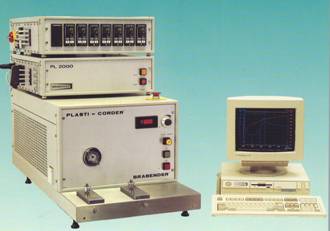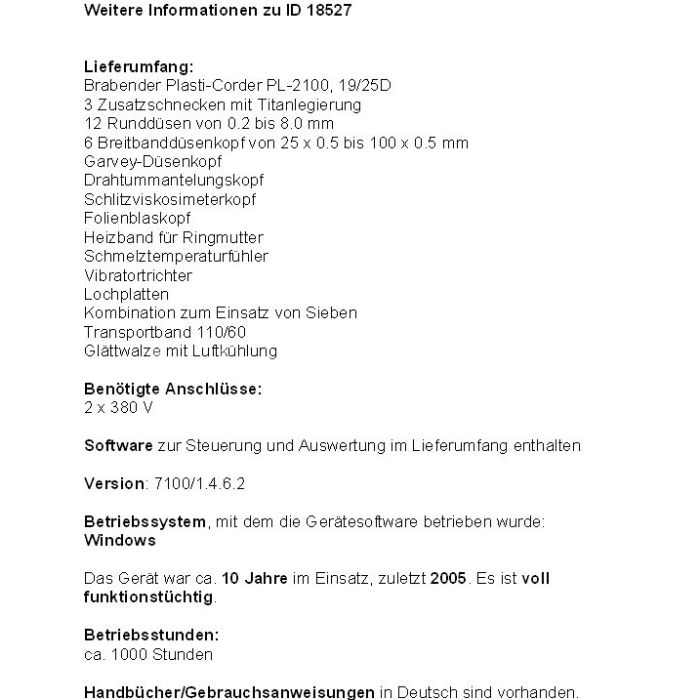Brabender PL-2100
| Objektnummer | B00018527 |
|---|---|
| Seriennummer | 018527 |
| Object Naam | Brabender PL-2100 |
| Status | Stock unit |
Product groep: Process Engineering / Plants
Status, leverings- en betalingsvoorwaarden
Apparatuurcontrole
De gebruikte apparatuur wordt voorafgaand aan levering gecontroleerd door Labexchange Service GmbH. U ontvangt volledig functionerende apparatuur.
Verzending
De vermelde verzendtijden zijn telkens de kortste voor een artikel. In bepaalde gevallen kunnen de daadwerkelijke verzendtijden daarvan afwijken. De uiteindelijke verzendtijden worden aangegeven in de opdrachtbevestiging.
In de regel bieden we combinatieleveringen aan. Levertijden zijn afhankelijk van het artikel met de langste levertijd. Deelleveringen zijn mogelijk tegen een toeslag.
Verzendmethoden
Koeriersdiensten, transportbedrijven, zelf afhalen, levering door Labexchange wagenpark
Informatie levering
De prijzen zijn exclusief verzendkosten. De genoemde verzendkosten zijn de te verwachten kosten. Afwijkingen zijn mogelijk. In het geval geen kosten voor verzending zijn gespecificeerd, vraag die dan afzonderlijk aan.
De opgegeven vracht- en verpakkingskosten hebben betrekking op de goedkoopste transportroute en zijn onder voorbehoud van onvoorziene kostenstijgingen. Door onvoorziene gebeurtenissen kunnen vrachttarieven en levertijden op elk moment veranderen en moeten ze worden aangepast aan de huidige situatie. Incoterm coderingen volgens Incoterms 2010: Bij afhalen EXW, CFR voor zendingen over zee, CPT per luchtfracht, andere zendingen DAP. Opmerking: We geven geen preferentieel certificaat/EUR1 af. Bij zelf afhalen/af fabriek (EXW) uit derde landen en de EU wordt 16% btw als borg ingehouden, tot we de ontvangstbevestiging/het leveringscertificaat van de koper hebben ontvangen.
Betalingsvoorwaarden
Wij accepteren geen betalingen Letter of Credit, PayPal etc. Het factuurbedrag is volledig verschuldigd. Er zijn geen betalingskortingen. De goederen blijven tot volledige betaling ons eigendom.
|
Land |
Mogelijke betaalmethoden |
Opmerking |
|
Duitsland, Oostenrijk, Zwitserland |
Betaling via factuur, vooruitbetaling, per creditkaart |
Betaling via factuur is mogelijk voor ondernemingsklanten. |
|
Nederland, België en Luxemburg |
Betaling via factuur, vooruitbetaling, per creditkaart |
Betaling via factuur is mogelijk voor ondernemingsklanten. |
|
Andere landen |
vooruitbetaling, per creditkaart |
|
Onze Algemene Voorwaarden voor Verkoop, Levering en Betaling zijn hierop van toepassing. Deze voorwaarden zijn hier te downloaden.
Tussenverkoop is ons voorbehouden.
Beschrijving status:
Alle artikelen zijn gebruikte artikelen, tenzij bij een artikel uitdrukkelijk wordt vermeld dat het om een nieuw apparaat gaat.
manufacturer : Brabender
model : PL-2100
annotation : Dokumente engl .

The BRABENDER® Torque Rheometers :
PLASTOGRAPH® and PLASTI-CORDER®
BRABENDER® PLASTOGRAPH and PLASTI-CORDER® are torque rheometers with registration and/or monitor display and automatic evaluation of the measuring results including colour printout. They are easy-to-handle high-precision measuring instruments for thermoplastics, thermosets , elastomers , and many other plastic and plastifiable materials. Minimum sample volumes can be examined in practice-oriented tests for their quality and processibility in order to find out the Optimum processing conditions for the respective material. Quality assurance measurements with a large variety of materials can also be run continuously, e.g. parallel to the production process. The DATA PROCESSING PLASTI-CORDER® evaluates the measuring results fully automatically. The electronic PLASTI-CORDER® with analog data registration can be ulteriorly equipped with a computer as well.
Modular System
The measuring instruments are designed according to the modular system and can easily be adapted to the individual requirements of the user. Numerous measuring heads such as measuring mixers, measuring extruders, etc. can be interchanged within very short time. A PLASTOGRAPH® or a PLASTI-CORDER® with various measuring heads thus permits to run many different tests which, either an their own or in combination with other measurements, supply reliable data and permit a sound evaluation of the sample material. Therefore, the BRABENDER® PLASTOGRAPH®and PLASTI-CORDER® are a valuable help not only for experts in production but also for scientists in research and development.
Practice-Oriented Test Conditions
The Parameters influencing the viscosity of a material, such as temperature of the measuring heads and/or shear rate can be varied within a wide range. lt is, thus, possible to create test conditions corresponding exactly to those occurring in large-scale mixers, moulding presses, calenders , extruders, and screw injection moulding machines. When the influence of the test conditions onto the sample material is known, adjustment of the processing conditions at the production machines is no longer a problem.
Measuring Principle
In plastics and rubber industry, numerous test methods are known for determining the viscosity and the processibility of polymers, e.g. by means of parameters determined statically such as the K-value. Very often, however, these methods are based upon test conditions that are far away from practice. In contrast to that, PLASTOGRAPH® and PLASTI-CORDER® use a practice-oriented, dynamic test method. The measuring principle is based an making visible the resistance opposed by the sample material to the rotating blades, rotors, screws, etc. in the measuring mixer or in the measuring extruder. The corresponding torque moves a dynamometer out of its zero position. In accordance with the existing test specifications, a typical PLASTOG RAM (torque versus time diagram), showing also the stock temperature curve, is recorded for each sample material. Thus, the direct relationship between viscosity and stock temperature can be seen. The measuring results can be evaluated rheologically with regard to the apparent viscosity of the sample material.
Raw Material Quality Assurance for Recipe Development
If the test conditions set at the PLASTOGRAPH® or PLASTICORDER® are kept constant, the PLASTOGRAMS clearly show the influence of recipe modifications onto the processibility of the material. In other words, the influence of e.g. stabilizers, plasticizers, lubricants, fillers, catalysts, and pigments can be determined.
The PLASTOGRAPH® and PLASTI-CORDER® are best suited for checking the quality of incoming raw material and for continuous quality assurance measurements in mixing departments where samples of each new batch are tested and compared to standard PLASTOGRAMS of proven material. The user-optimized BRABENDER® software offers numerous advantages: not only are the tests evaluated fully-automatically, but several tests or different parts of one or more tests can be correlated. Furthermore, the software supports the definition of MASTERCURVES serving as a reference for given quality standards. The user can, thus, determine immediately during the subsequent test or any time later whether e.g. a compound meets certain requirements or not.
Testing the Processibility
Formerly, the BRABENDER® torque rheometers were applied primarily as viscometers in a narrower sense for measuring the viscosity of polymer melts. There is no doubt that the melt viscosity of homogeneous, non-Newtonian compounds represents an important parameter when such melts are subjected to dynamic shearing. However, melt viscosity measurements using only a single measuring head do not completely define the " processibility " of a material. For this reason, the program of interchangeable measuring heads for the BRABENDER° PLASTOGRAPH®and PLASTI-CORDER® has been extended continuously. By means of tests with measuring mixers, planetary mixer, and measuring extruders with many different die heads, special processing steps occurring in production machines can be simulated in order to determine further material characteristics that are relevant for the production process.
Special measuring mixers are available for determining the Fusion and plastification behaviour of PVC compounds. These tests supply reliable data e.g. about the influence of the different material components on the transformation of the granules or powder into a homogeneous melt which is of utmost importance for the extrusion process. Other measuring mixers serve for studying the melt viscosity and the heat and shear stability, i.e. the variation of the viscosity of the polymer as a function of the combined influence of temperature and shear due to chemical and/or physical changes in the materials tested.
With a PLANETARY MIXER, the particle structure of PVC powders is determined by measuring the plasticizer absorption and the pourability of the compounds.
lt is reasonable to complete the tests with measuring mixers by laboratory extruder tests. Different types of extruders developed for various applications and numerous die heads are available for determining the extrudability of polymers. The viscosity and the flow of the melt through different dies is observed, and the extrudate is checked for melt fracture, swelling, gloss, gels, pigment dispersion, etc. By ejecting the extruder screw at the end of the test, the melt spiral on the screw gives a picture of the processing conditions along the screw. Equipped with one of the manifold capillary die heads, the extruder can be used as a capillary viscometer in production control and in research and development for simultaneously measuring the melt pressure and the melt temperature in the extruder as well as the output per unit of time.
Each of the individual measuring methods covers certain criteria of the processibility which are based an different parameters. The shape and the size of the individual particles of PVC dry blends which determine the flowability of the compound loose their influence as soon as the material has been transformed into a homogeneous melt. While the melt viscosity of a polymer results from the combination of different factors such as e.g. the molecular weight of the polymer and of other components like lubricants, stabilizers, etc., the flow of the melt through a die may be influenced by some additional factors, too, such as the elastic deformation of the melt, the wall adhesion within the die channels, segregation of individual components in the extruder or in the die head as it can be observed with some titanium dioxides, swelling of the extrudate after leaving the die, etc.
Using a large variety of measuring methods, the BRABENDER° PLASTOGRAPH® and PLASTI-CORDER® permit to completely describe the processibility of a material. The measuring instruments are continuously improved, and new types are developed in order to always meet the state of the art and to comply with special requirements of our customers.







